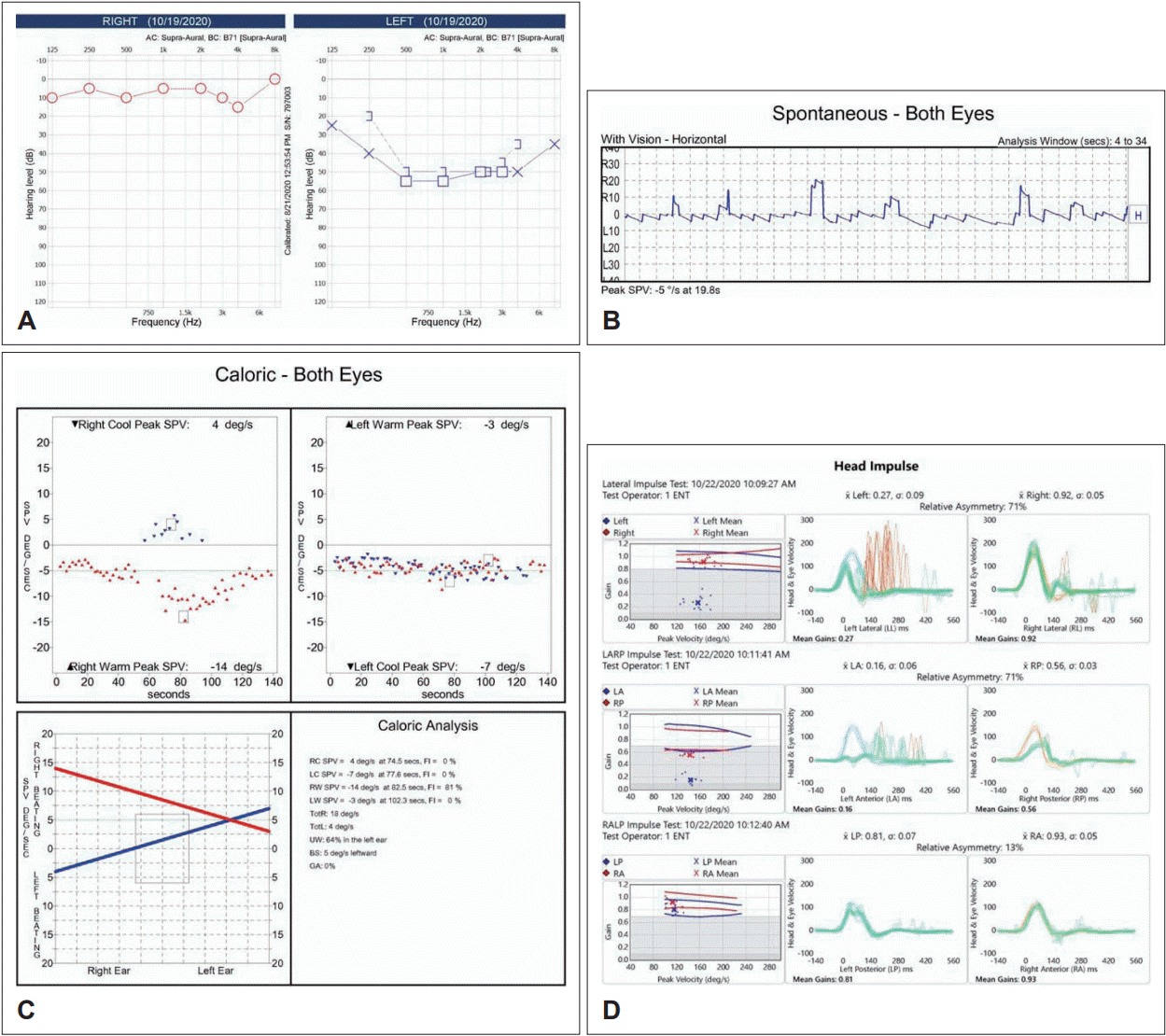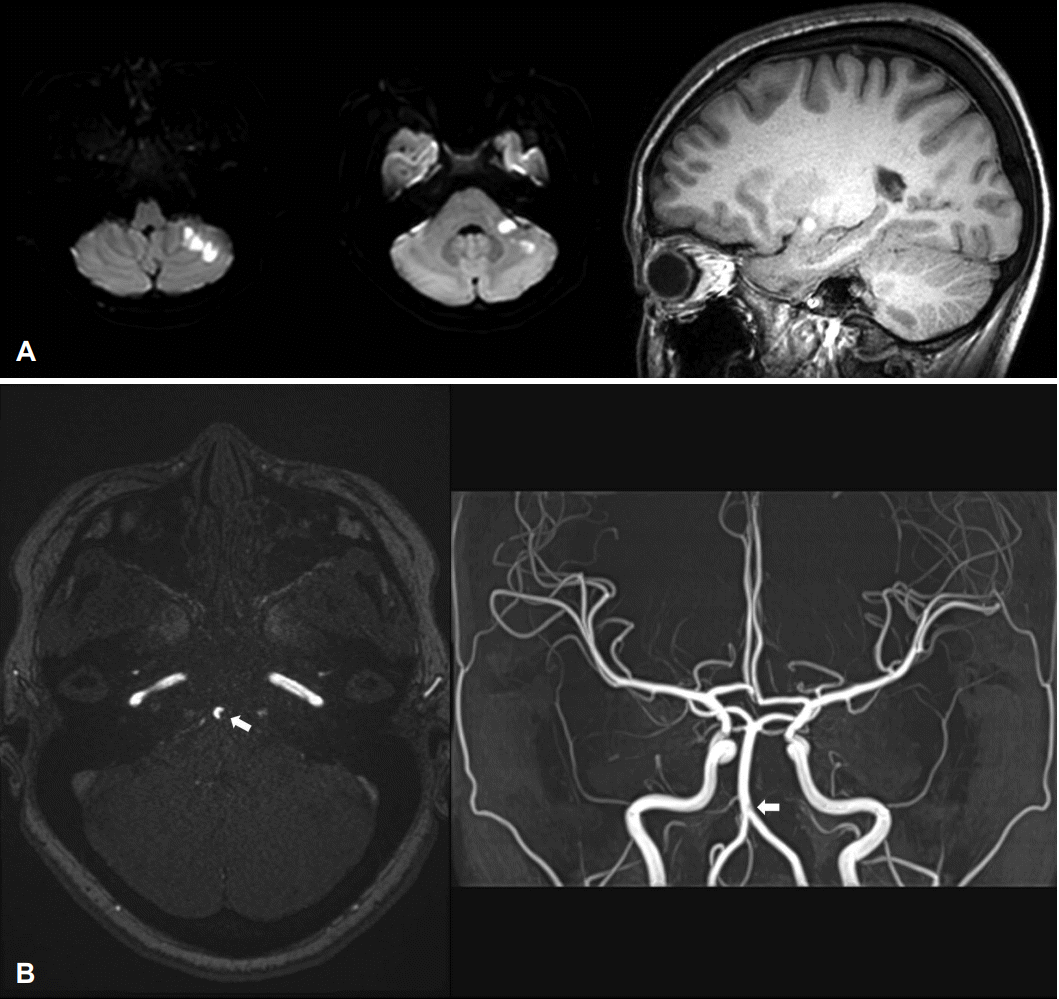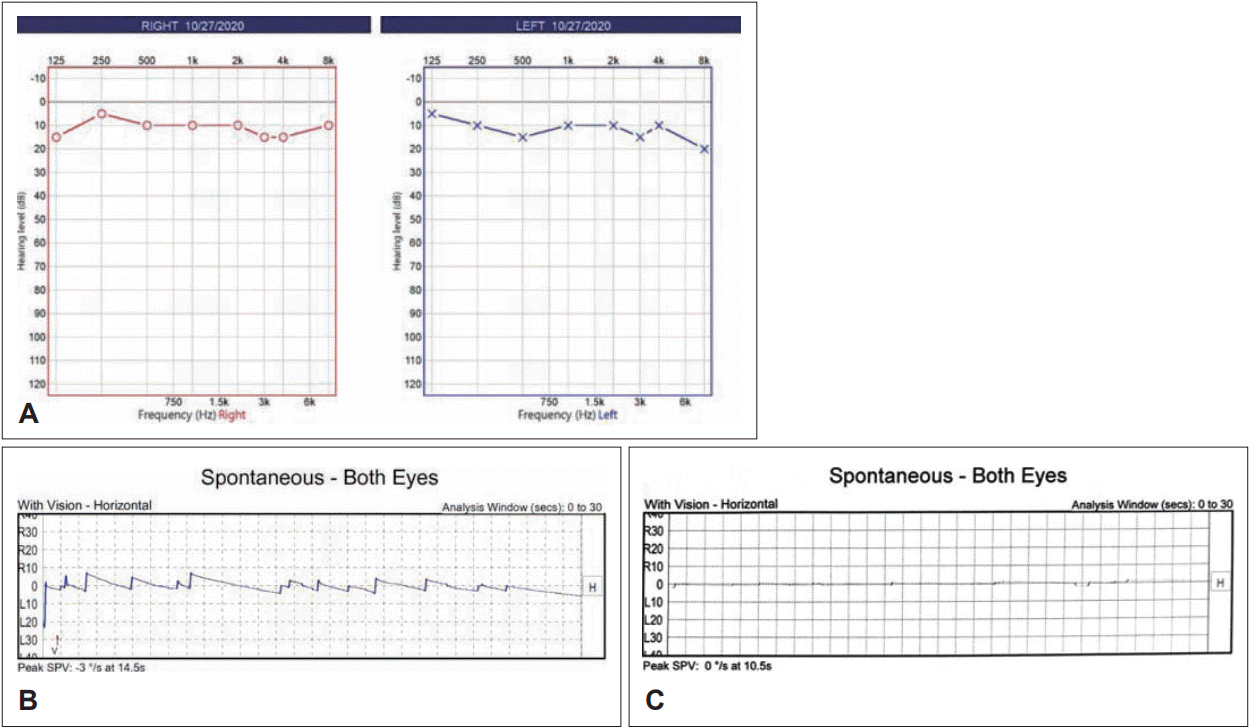Abstract
Basilar artery dissection (BAD) is a rare cause of vertigo in children. A 15-year-old girl presented with sudden vertigo and unilateral hearing loss. Magnetic resonance imaging revealed posterior circulation infarction caused by BAD. After antiplatelet therapy, intratympanic injections of dexamethasone and vestibular rehabilitation, her symptoms improved. We report this case of BAD, which might be mistaken for acute peripheral vestibular disorders in the early stage.
A 15-year-old girl patient was admitted to the emergency unit complaining of whirling vertigo and hearing loss on the left side that started 1 hour ago from the admission. In the medical history of the patient, there was no history of head trauma, underlying disease, or relevant family history. From 2 weeks ago, the mild dizziness repeatedly occurred for several seconds when lifting head. The patient complained of no other neurological symptoms. Brain CT performed in the emergency unit showed no specific lesions and was referred to our department suspecting acute labyrinthitis.
In the Frenzel glasses test, a right-beating, horizontal and spontaneous nystagmus were observed. Also, on the positional test including both Dix-Hallpike test and head roll test, the direction of nystagmus has not changed. On lateral head impulse test, corrective catch-up saccade was observed at the left side. Also, neither skew deviation nor gaze-evoked nystagmus were observed. The finger to nose test, heel to shin test, and rapid alternating movement test revealed no abnormal findings, however, severe sway indicating truncal ataxia was observed on Romberg test and tandem gait. Both eardrums were intact, but unilateral sensorineural hearing loss was suspected by tuning fork test.
Pure tone audiometry confirmed the threshold of 52 dB on the left ear (Fig. 1A), and the auditory brainstem response using click sound also showed the threshold of 40 dB with the normal interpeak latency (wave I to V). And video nystagmography showed the right-beating spontaneous nystagmus with the peak slow phase velocity of 5°/sec, and caloric test revealed the canal paresis of 64% at the left ear. Her video head impulse test also showed the decreased gain of the left horizontal semicircular canal and catch-up saccade were observed at the left lateral impulse (Fig. 1B-D).
To rule out cerebellar lesions, brain magnetic resonance imaging (MRI) and angiography (MRA) were performed. Diffusion-weighted MRI revealed multifocal, highly-diffused infarction in the left cerebellum, and a loss of signal intensity of about 2 mm was observed in the left basilar artery in MRA (Fig. 2A). An additional vessel wall MRI revealed a 2×3 mm focal dissection in the left side of the basilar artery (Fig. 2B). Finally, the posterior circulation infarction caused by the left basilar artery dissection (BAD) was confirmed. On further examination including echocardiography and 24-hour Holter monitoring, no abnormal finding was observed.
After the admission to the stroke unit, 200 mg of aspirin and 10 mg of atorvastatin were administered daily. For the left sensorineural hearing loss, a total of 4 times of intratympanic injections of dexamethasone (5 mg/mL) were performed. On the 8th day, vertiginous symptoms improved, and Romberg test and tandem gait showed no falling. The left hearing was also recovered to normal (Fig. 3A). Conventional vestibular rehabilitation has started. At the week 3, no vertigo and gait disturbance were complained, but the spontaneous nystagmus persisted in amplitude to 3°/sec (Fig. 3B). At the 2-year follow-up, no spontaneous nystagmus or truncal ataxia were observed (Fig. 3C), and there was no deterioration of arterial dissection on vessel wall MRI.
Prevalence of dizziness in children is lower than adults, which has been reported to be 0.7%-15% [3]. Pediatric dizziness has a different etiologies from adults, and common causes are benign paroxysmal vertigo and vestibular migraine, which account for about 35% of the total causes of dizziness, followed by Meniere’s disease and others such as orthostatic dizziness, vasovagal syncope [1]. However, central causes are very rare at less than 1%, which include cerebrovascular disease, temporal bone tumors, and brain tumors [2].
Acute ischemic stroke in children is known to be a rare condition with an annual incidence of 1.6 per 100000, and its causes are similar to those of adults, which include embolism, large-artery atherosclerosis, small vessel disease, and arterial dissection [4]. Of those, cranio-cervical arterial dissection in children usually presents with symptoms of acute ischemic stroke or transient ischemic attack, occurring in 2.5 per 100000 children annually [5].
BAD is less frequently observed in children, but it can cause brainstem and cerebellar infarction or subarachnoid hemorrhage with various symptoms such as hemiparesis, dizziness, headache, vomiting, diplopia, visual field defect, visual impairment, ataxia, and paresthesia [6]. Risk factors include head and neck trauma, cervical spine abnormalities, or connective tissue disorder such as fibromuscular dysplasia, however, idiopathic BAD as like this patient accounts for about 26% [6,7]. Various symptoms have been reported such as dizziness, nausea/vomiting, headache, visual field defect and consciousness disorders [8]. In children, posterior circulation dissection is known to be more common than anterior circulation dissection [9]. However, there are currently no established diagnostic criteria, methodology, and treatment guidelines for isolated BAD.
For the diagnosis of BAD, conventional angiography (CA) is the gold standard in both children and adults. However, it requires sedation, is invasive, and may cause serious critical complications (e.g. femoral hematoma, femoral arterial pseudoaneurysm, and radiation exposure). Therefore, MRA is increasingly used as an alternative [9,10]. MRA shows higher sensitivity than CA in identifying intramural hematoma, short-segment dissections and lesions in tortuous or small-diameter vessels [7,9]. In particular, vessel wall MRI is effective in evaluating the structure of the inner vessel wall and lumen, and capable of detecting intimal flaps, double lumina, and wall thickening better than CT angiography [10].
Antiplatelet therapy and anticoagulation are recommended for the treatment of pediatric acute ischemic stroke, but there is no randomized controlled trial comparing the two treatment methods. The most used antiplatelet agent is aspirin, prescribed at a dose of 2 to 5 mg/kg per day [11]. According to a recent pediatric stroke guideline, anticoagulation therapy such as unfractionated heparin, low-molecular-weight heparin, or warfarin is recommended for extracranial cranio-cervical arterial dissection [11]. Limited interventional procedures such as stent or balloon angioplasty are performed only in patients who have failed pharmacological treatment [12].
Since systemic steroids can aggravate arterial dissection by increasing vessel wall fragility and blood pressure [13],she was treated with intratympanic dexamethasone instead. In an animal study, recovery of cochlear blood flow after release of the anterior inferior cerebellar artery (AICA) clamp was reported after intratympanic dexamethasone [14].
In case of BAD, thrombus formed in false lumen decreases blood flow and increases the risk of thromboembolism, leading to poor prognosis, and it is a serious disease with a significant mortality rate [6]. Therefore, if appropriate treatment is not provided in the early stage, it may lead to fatal outcomes for the patient, highlighting the necessity for fast differential diagnosis and treatment.
When the blood flow of posterior circulation is reduced due to BAD, abnormal findings can be identified in areas dominated by the AICA and posterior inferior cerebellar artery (PICA). Since AICA branches the labyrinthine artery that supplies blood to the cochleo-vestibular system, abnormal blood flow of AICA can show sudden vertigo along with hearing loss [15]. Because PICA supplies blood flow to the cerebellum and the lower brainstem, its abnormalities can cause ataxia and gait disturbance as well as various brainstem signs [5,6].
In this patient, it is speculated that sudden vertigo and hearing loss occurred by transient ischemia of labyrinthine artery branching from AICA because of BAD. However, since she showed contralesional spontaneous nystagmus and ipsilesional catch-up saccade on vHIT without both skew deviation and gaze-evoked nystagmus (HINTS exam), it could be misdiagnosed with peripheral vestibular disorders such as acute labyrinthitis or sudden sensorineural hearing loss with vertigo. Interestingly, video head impulse test of the posterior semicircular canal showed neither corrective saccade or abnormal gain unlike the horizontal and the superior canals. As a possible hypothesis, the posterior canal is supplied by the posterior vestibular artery unlike other canals, so there might be a difference in the degree of damage after a transient ischemic event.
But we found her truncal ataxia and gait disturbance on Romberg test and tandem gait, which presumed possible cerebellar lesion, therefore, we were able to perform MRI/MRA and confirm multifocal infarction of the cerebellum. We assume that thrombus and low blood flow caused by BAD was its possible etiology. Even though the incidence of acute ischemic stroke in children is very low, persistent truncal ataxia and gait disturbance should be checked for accurate diagnosis. And brain MRI/MRA is considerably useful to identify BAD.
In conclusion, BAD is very rarely observed in children, and differential diagnosis is difficult because symptoms in early stage are similar with those in acute peripheral vestibular disorders. However, since BAD is a disease that can have irreversible complications and a significantly unfavorable prognosis, it is essential to include BAD in the differential diagnosis. If a child patient shows acute vertigo with symptoms such as truncal ataxia and gait disturbance, ischemia of posterior circulation should be considered as a possible etiology.
REFERENCES
1. Gioacchini FM, Alicandri-Ciufelli M, Kaleci S, Magliulo G, Re M. Prevalence and diagnosis of vestibular disorders in children: A review. Int J Pediatr Otorhinolaryngol. 2014; 78(5):718–24.
2. Lee JD, Kim CH, Hong SM, Kim SH, Suh MW, Kim MB, et al. Prevalence of vestibular and balance disorders in children and adolescents according to age: A multi-center study. Int J Pediatr Otorhinolaryngol. 2017; 94:36–9.
3. Riina N, Ilmari P, Kentala E. Vertigo and imbalance in children: A retrospective study in a Helsinki University otorhinolaryngology clinic. Arch Otolaryngol Head Neck Surg. 2005; 131(11):996–1000.
4. Mallick AA, Ganesan V, Kirkham FJ, Fallon P, Hedderly T, McShane T, et al. Childhood arterial ischaemic stroke incidence, presenting features, and risk factors: A prospective population-based study. Lancet Neurol. 2014; 13(1):35–43.
5. Fullerton HJ, Johnston SC, Smith WS. Arterial dissection and stroke in children. Neurology. 2001; 57(7):1155–60.
6. Ruecker M, Furtner M, Knof lach M, Werner P, Gotwald T, Chemelli A, et al. Basilar artery dissection: Series of 12 consecutive cases and review of the literature. Cerebrovasc Dis. 2010; 30(3):267–76.
7. Tsao YW, Chen JH, Huang PH, Chen WL. Isolated basilar artery dissection--a rare cause of stroke in young adult. Am J Emerg Med. 2013; 31(9):1422.e3–5.
8. Brandt T, Orberk E, Weber R, Werner I, Busse O, Müller BT, et al. Pathogenesis of cervical artery dissections: Association with connective tissue abnormalities. Neurology. 2001; 57(1):24–30.
9. Tan MA, DeVeber G, Kirton A, Vidarsson L, MacGregor D, Shroff M. Low detection rate of craniocervical arterial dissection in children using time-of-flight magnetic resonance angiography: Causes and strategies to improve diagnosis. J Child Neurol. 2009; 24(10):1250–7.
10. Obusez EC, Jones SE, Hui F. Vessel wall MRI for suspected isolated basilar artery dissection. J Clin Neurosci. 2016; 27:177–9.
11. Roach ES, Golomb MR, Adams R, Biller J, Daniels S, Deveber G, et al. Management of stroke in infants and children: A scientific statement from a special writing group of the American Heart Association Stroke Council and the council on cardiovascular disease in the young. Stroke. 2008; 39(9):2644–91.
12. Kirton A, Wong JH, Mah J, Ross BC, Kennedy J, Bell K, et al. Successful endovascular therapy for acute basilar thrombosis in an adolescent. Pediatrics. 2003; 112(3 Pt 1):e248–51.
13. Chung SE, Yoon TH, Lee KM, Kim HG, Kim BJ. A case report of multiple cervical artery dissection after peripheral type facial palsy and use of steroids. BMC Neurol. 2018; 18(1):74.
14. Otake H, Yamamoto H, Teranishi M, Sone M, Nakashima T. Cochlear blood flow during occlusion and reperfusion of the anterior inferior cerebellar artery--effect of topical application of dexamethasone to the round window. Acta Otolaryngol. 2009; 129(2):127–31.
15. Oas JG, Baloh RW. Vertigo and the anterior inferior cerebellar artery syndrome. Neurology. 1992; 42(12):2274–9.
Fig. 1.
Audiologic and vestibular function tests. A: Sudden sensorineural hearing loss at the left ear on pure tone audiometry. B: Right-beating spontaneous nystagmus with peak slow phase velocity (SPV) of 5°/sec. C: Canal paresis of 64% at the left ear. D: Decreased gain, overt and covert saccades at the left ear on lateral head impulse.

Fig. 2.
Magnetic resonance imaging (MRI). A: Brain MRI. Diffusion-weighted sequences demonstrate multifocal high signal intensity in the left cerebellum. B: Vessel wall MRI and MR angiography. It shows 2×3 mm of focal signal defect in the left side of the basilar artery (arrow), and it suggests basilar artery dissection.





 PDF
PDF Citation
Citation Print
Print




 XML Download
XML Download